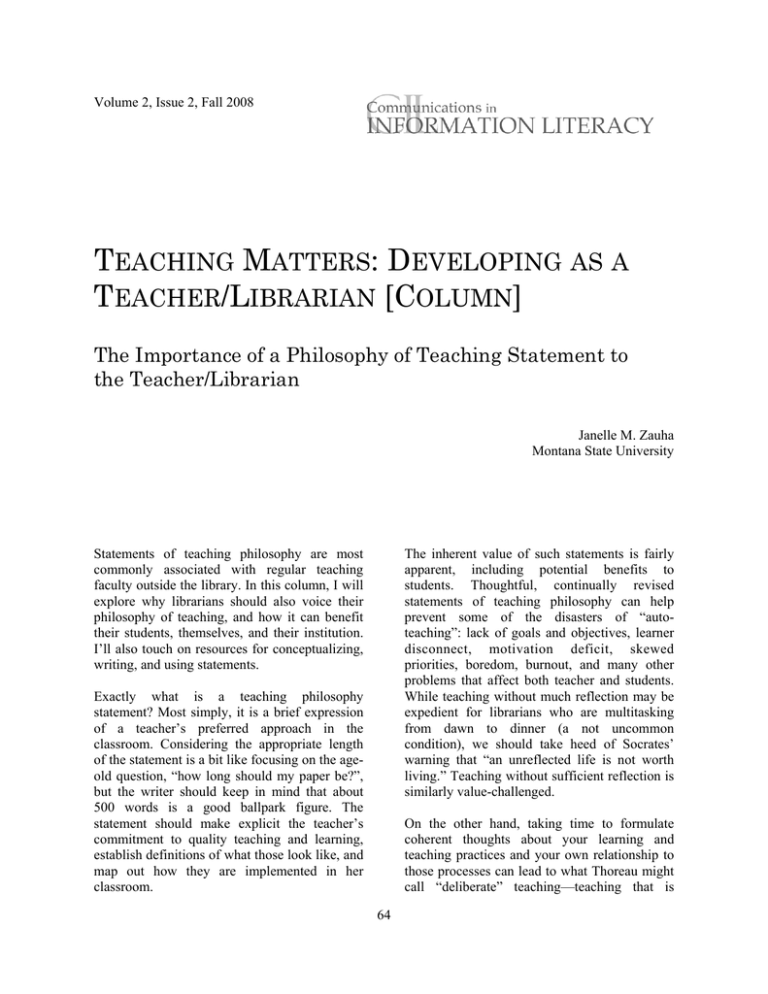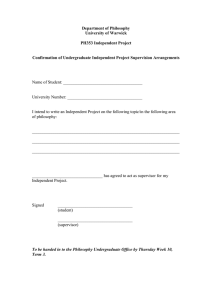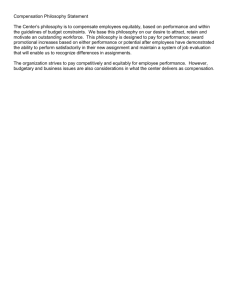T M : D
advertisement

Volume 2, Issue 2, Fall 2008 TEACHING MATTERS: DEVELOPING AS A TEACHER/LIBRARIAN [COLUMN] The Importance of a Philosophy of Teaching Statement to the Teacher/Librarian Janelle M. Zauha Montana State University The inherent value of such statements is fairly apparent, including potential benefits to students. Thoughtful, continually revised statements of teaching philosophy can help prevent some of the disasters of “autoteaching”: lack of goals and objectives, learner disconnect, motivation deficit, skewed priorities, boredom, burnout, and many other problems that affect both teacher and students. While teaching without much reflection may be expedient for librarians who are multitasking from dawn to dinner (a not uncommon condition), we should take heed of Socrates’ warning that “an unreflected life is not worth living.” Teaching without sufficient reflection is similarly value-challenged. Statements of teaching philosophy are most commonly associated with regular teaching faculty outside the library. In this column, I will explore why librarians should also voice their philosophy of teaching, and how it can benefit their students, themselves, and their institution. I’ll also touch on resources for conceptualizing, writing, and using statements. Exactly what is a teaching philosophy statement? Most simply, it is a brief expression of a teacher’s preferred approach in the classroom. Considering the appropriate length of the statement is a bit like focusing on the ageold question, “how long should my paper be?”, but the writer should keep in mind that about 500 words is a good ballpark figure. The statement should make explicit the teacher’s commitment to quality teaching and learning, establish definitions of what those look like, and map out how they are implemented in her classroom. On the other hand, taking time to formulate coherent thoughts about your learning and teaching practices and your own relationship to those processes can lead to what Thoreau might call “deliberate” teaching—teaching that is 64 Zauha, Teaching Matters Communications in Information Literacy 2(2), Fall 2008 choose to make librarians’ teaching philosophy statements available on its Web site, highlighting them in the same way other departments do for their faculty. This can heighten the library’s profile on campus, make its contribution to the university’s mission more apparent, and reinforce its commitment to student success. From a faculty governance point of view, statements of teaching philosophy are becoming more common components of the tenure and promotion dossier, and can serve to explain to more traditional faculty the ways in which librarians share a similar teaching identity. worth doing, that has meaning for both the teacher and the student, and has the vitality of continual evolution. Conceptualizing a statement of teaching philosophy is a basic step in the direction of becoming a thoughtful practitioner. It is important that this philosophy be written out by the teacher herself, and that it does not simply exist in her mind or in fragments on her syllabi. The act of writing requires structured reflection and a text serves as a persistent reminder of priorities and values. A written statement is also more easily shared with students and colleagues. Beyond the classroom, there are many benefits for the teacher, her colleagues, and her institution. The savvy teacher/librarian can make her statement of teaching philosophy work in several areas of her professional life. She can use it to define and assert her identity as a teacher—something that is not always easy for librarians in the academy. It can be a source of personal and professional power, and boost selfconfidence. She can bring it to the curriculum planning table and meet other teaching faculty on more common and equal ground. She can function as a collaborator who has established personal standards, pedagogies, and knowledge that she contributes to the co-creation of the best possible learning environment. If her statement vividly reflects her teaching personality and passion, it is also a form of self-expression and an outlet for creativity, and can help shield her against instruction burnout. These benefits and uses combine to make it worth even the most harried teacher/librarian’s time to do what our students are often required to do in the classroom: stop multitasking, focus, reflect, write, and revise, revise, revise. The good statement of teaching philosophy is never perfect and is never finished, not unlike the good Web site. It must be periodically refined and refocused to suit changing learner needs and characteristics and to express the reflective teacher’s evolving self in the classroom. To help you explore what should be included in a statement of teaching philosophy and how to begin writing one, the Web provides many excellent resources. Here are some ideas and sites to get you started: In a larger sense, library instruction teams whose members have gone through the process of writing and sharing statements of teaching philosophy have the potential to create more cohesive, fully functioning instruction programs, even though their teaching philosophies will undoubtedly differ. They can model varieties of reflective teaching for newer librarians, and they will have taken important steps toward establishing recognizable standards for quality teaching and learning on the team. These teams are thus better equipped to deliver more uniformly effective library instruction. Beyond the team environment, a library may 65 • See if your institution has guidelines or resources available. These may be online through a faculty handbook or from a campus center for teaching and learning. • See “Your Teaching Philosophy Statement” (http://unbf.ca/cetl/ r e s o u r c e s / d o c u m e n t s / TeachingPhilosophyStatement.pdf), by Ellen Carusetta of the University of New Brunswick, which has an extensive section on different approaches to drafting your statement. • See “Statements of Teaching Philosophy ” (http:// Zauha, Teaching Matters Communications in Information Literacy 2(2), Fall 2008 sunconference.utep.edu/CETaL/ resources/stofteach.html), by Gail E. Goodyear and Douglas Allchin of The Center for Effective Teaching and Learning at the University of Texas at El Paso, a robust article that provides extensive discussion about settings, roles, creation, and content for teaching statements. • Search Google for “sample teaching philosophy statements” (or some variant thereof) and read statements others have written; but keep in mind that not everything you read is a model! Statements specifically from librarian/ teachers are harder to locate. Communications in Information Literacy publishes invited editorial content, including reviews of books and other media, interviews with select figures in the information literacy community, and guest editorial and opinion. If you are interested in contributing editorial content to the journal, please inquire with the Editors (editors@comminfolit.org). 66



